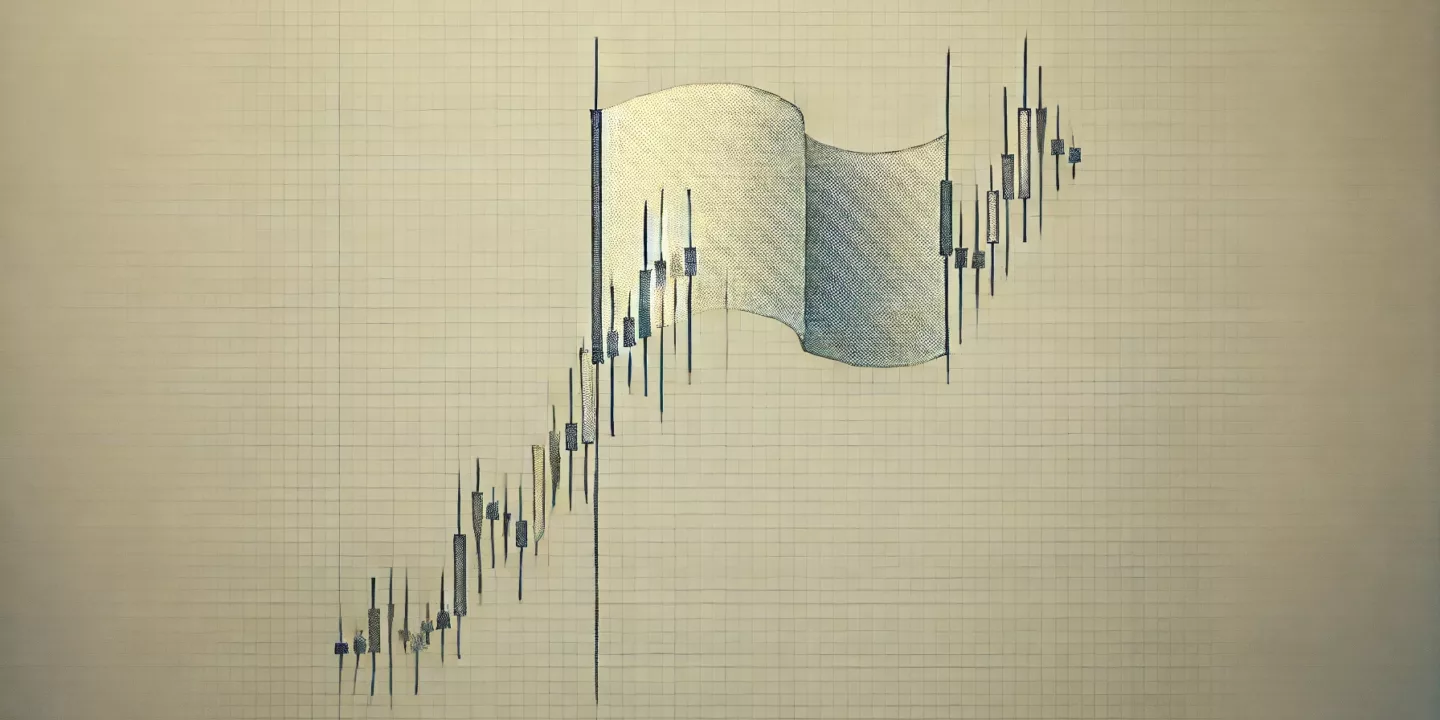Cryptocurrency trading involves analyzing various chart patterns to make informed decisions. One such pattern, the bear flag, is essential for traders to recognize. Understanding the bear flag pattern can provide valuable insights into potential price movements and help traders make informed decisions.
In this article, we will delve into what a bear flag pattern in crypto is, how to identify it, and its significance in cryptocurrency trading. We will break down the components of a bear flag pattern, explain how it forms, and discuss what it indicates about the market’s direction.
Key Takeaways
- What is a Bear Flag Pattern?
- How to Identify a Bear Flag Pattern in Crypto
- Advantages and Limitations of Bear Flag Pattern
What is a Bear Flag Pattern?
A bear flag pattern is a technical analysis chart pattern used by traders to predict future price movements in the market. It is called a “bear flag” because it signals a continuation of a downtrend, similar to how a flag waves in the wind.
The pattern consists of two main parts: the flagpole and the flag. The flagpole represents a sharp price drop, followed by the flag, a period of consolidation where the price moves in a narrow, upward-sloping channel.
This flag formation is usually marked by lower trading volume. The bear flag pattern indicates that after this brief consolidation, the price will likely continue falling, resuming the initial downtrend.
Recognizing this pattern on a crypto chart can help traders anticipate potential selling opportunities and manage their risk more effectively. Understanding the bear flag pattern allows traders to make more informed decisions and improve their chances of success in the cryptocurrency market.
Why Use a Bear Flag Pattern in Crypto trading?
Here are several reasons why understanding and using the bear flag pattern in cryptotrading can improve your overall crypto trading strategy:
Predicting Continuation of Downtrends
The primary purpose of identifying a bear flag pattern is to anticipate the continuation of a downtrend. Spotting this pattern signals that the market will resume its downward trajectory after a brief consolidation period. This insight helps traders prepare for potential price drops.
Timing Entry and Exit Points
By recognizing a bear flag pattern, traders can better time their entry and exit points. Entering a short position when the pattern is confirmed can increase the chances of capitalizing on the subsequent price decline. Similarly, it can help decide when to exit long positions to minimize losses.
Risk Management
Using the bear flag pattern can improve risk management. Knowing that a continuation of a downtrend is likely allows traders to set more accurate stop-loss orders, reducing the risk of significant losses. It also helps plan trades with a clearer understanding of potential price movements.
Enhancing Trading Strategy
Integrating the bear flag pattern into your trading strategy can provide an additional layer of analysis. Combining this pattern with other technical indicators and market analysis techniques can lead to more informed and strategic trading decisions.
Building Confidence
Understanding and effectively using chart patterns like the bear flag can build confidence for both new and experienced traders. Successfully recognizing and interpreting these patterns can lead to a better grasp of the market and improve trading performance.
How to Identify a Bear Flag Pattern in Crypto?
Identifying a bear flag pattern in crypto charts requires careful observation of price movements and volume trends. Here is how you can recognize this pattern:
Identify the Flagpole
The first component of the bear flag pattern is a significant and rapid decline in price, forming the flagpole. This drop should be steep and occur over a short period, indicating a strong bearish sentiment. This sharp decline is typically accompanied by high trading volume, reflecting the intense selling pressure.
Spot the Flag
After the sharp decline, the price enters a consolidation phase, forming the flag. During this period, the price moves within a narrow, upward-sloping channel or a horizontal range. The consolidation phase is usually characterized by decreasing trading volume, indicating a temporary pause in the selling pressure.
Recognize the Flag’s Structure
The flag part of the pattern is defined by two parallel trend lines that contain the price action. These lines can either slope slightly upwards or horizontally. Within the flag, the price movements are smaller and less volatile compared to the flagpole, showing a temporary period of balance between buyers and sellers.
Look for the Breakout
The bear flag pattern is confirmed when the price breaks below the lower trend line of the flag, resuming the initial downtrend. This breakout is often accompanied by an increase in volume, signaling the continuation of the bearish move. Sometimes, the price may retest the lower trend line after the breakout before continuing to decline. This retest can provide additional confirmation of the pattern.
Verify with Other Indicators
To strengthen the identification of a bear flag pattern, consider using other technical indicators such as the Relative Strength Index (RSI), Moving Averages, or the MACD. These indicators can provide additional confirmation of the bearish trend and help in making more informed trading decisions.
How to Use the Bear Flag Pattern in Crypto trading?
Trading cryptocurrencies using the bear flag pattern involves a structured approach to capitalize on potential downtrends. Here is how to effectively trade using this pattern:
Step 1 – Identify the Bear Flag Pattern:
Begin by identifying a sharp and significant downtrend or flagpole, followed by a period of consolidation or the flag. The flag is characterized by price moving within a narrow, upward-sloping channel or a horizontal range with decreasing volume.
Step 2 – Confirm the Pattern:
Confirm the validity of the bear flag pattern by analyzing trading volume. The initial sharp decline of the flagpole should be accompanied by high trading volume, indicating strong selling pressure. During the flag formation, volume typically decreases, reflecting a temporary pause in the selling activity. The breakout from the flag should ideally occur with an increase in volume, signaling the continuation of the downtrend.
Step 3 – Entry Point:
Enter a short position once the price breaks below the lower trend line of the flag. This breakout confirms the resumption of the downtrend initiated by the flagpole. Make sure that the breakout is supported by sufficient volume to validate the trade setup.
Step 4 – Set Stop-Loss
Place a stop-loss order just above the upper trend line of the flag to protect against potential reversals. This level serves as a point of invalidation for the bearish setup.
Step 5 – Set a Target
Estimate the potential price decline by measuring the length of the flagpole. Extend this measured distance downwards from the breakout point to project a potential target for the price decline. This technique provides a rough estimate of where the price could reach following the breakout.
Step 6 – Monitor the Trade
Monitor the trade closely as the price moves towards your target. Consider adjusting SL orders to lock in profits or mitigate losses as the trade progresses. Stay aware of broader market conditions and news events that could impact cryptocurrency prices. Be prepared to adjust your trading strategy accordingly if market conditions change unexpectedly.
Step 7 – Exit Strategy
Consider taking profits as the price approaches your projected target based on the flagpole measurement. Secure gains by closing your short position and potentially looking for new trading opportunities. After exiting the trade, re-evaluate market conditions and look for new bear flag patterns or other trading opportunities that align with your trading strategy.
Advantages and Limitations of Bear Flag Pattern
The bear flag pattern offers traders a valuable tool for identifying potential downtrends in cryptocurrency markets, but it also comes with its set of advantages and limitations.
Advantages
Clear Signal for Downtrends
The primary advantage of the bear flag pattern is its ability to provide a clear signal of potential downtrends in the market. By identifying this pattern, traders can anticipate price declines and position themselves accordingly to capitalize on selling opportunities.
Effective Risk Management
Utilizing the bear flag pattern allows traders to implement effective risk management strategies. Setting SL orders just above the upper trend line of the flag helps minimize losses if the market moves against the anticipated downtrend.
Enhanced Timing of Entries and Exits
Traders can use the bear flag pattern to time their entries and exits more precisely. Entering a short position after the breakout from the flag and exiting near the projected price target improves trading efficiency and profitability.
Versatility Across Timeframes
The bear flag pattern is observable across various timeframes, from short-term intraday charts to longer-term daily or weekly charts. This versatility allows traders to apply the pattern in different trading contexts and timeframes.
Confirmation of Market Sentiment
The bear flag pattern signals a potential downtrend and confirms bearish market sentiment. By recognizing this pattern, traders gain insights into prevailing market conditions and investor psychology.
Scalability in Trading Strategies
Traders can scale their trading strategies effectively using the bear flag pattern. Whether trading short-term intraday movements or planning longer-term positions, the pattern’s clarity and structure allow for adaptable strategies tailored to different market conditions and timeframes.
Limitations
False Signals
Like any technical analysis pattern, the bear flag pattern is not foolproof and can occasionally produce false signals. Market volatility, unexpected news events, or sudden shifts in investor sentiment can invalidate the pattern, leading to losses if not managed carefully.
Subjectivity in Pattern Recognition
Identifying the bear flag pattern requires a subjective interpretation of price movements and trend lines. Different traders may perceive and draw trend lines slightly differently, potentially leading to variations in pattern recognition.
Confirmation Required
Successful trading based on the bear flag pattern requires confirmation through other technical indicators or market analysis tools. Relying solely on the pattern without additional confirmation can increase the risk of making incorrect trading decisions.
Market Conditions
The effectiveness of the bear flag pattern can vary depending on overall market conditions. In strongly trending markets or during periods of high volatility, patterns may form less reliably or exhibit shorter durations, impacting their predictive accuracy.
Emotional Trading
Traders can fall prey to emotional trading behaviors when using the bear flag pattern, especially if positions move against expectations. Discipline and adherence to predetermined trading strategies are essential to reduce emotional biases.
Conclusion
Learning about the bear flag pattern can boost your cryptocurrency trading skills. It helps you predict when prices might drop so you can make smarter moves. Remember, trading well means using both technical know-how and careful risk management. We learned in detail how you can identify and use the bear flag pattern in the cryptocurrency market; now it’s time to begin crypto trading. Download the Mudrex app to have a seamless experience in trading crypto assets.
FAQs
Why is it called a bear flag pattern?
The bear flag pattern gets its name because it resembles a flag waving in the wind. In trading, it signifies a continuation pattern in a downtrend, where after a sharp decline, there is a period of consolidation before the downtrend continues.
Can the bear flag pattern appear on different timeframes?
Yes, the bear flag pattern can appear on various timeframes, from short-term intraday charts to longer-term daily or weekly charts. The principles of identifying and trading the pattern remain similar across different timeframes.
What other technical indicators can confirm the bear flag pattern?
Traders often use technical indicators like the Relative Strength Index (RSI), Moving Averages, or the MACD (Moving Average Convergence Divergence) to confirm the bearish bias suggested by the bear flag pattern. These indicators provide additional insights into market momentum and trend strength.
Is the bear flag pattern reliable in all market conditions?
While the bear flag pattern is a useful tool, its reliability can vary depending on market conditions. Strongly trending markets or high volatility can affect pattern formation and duration, potentially impacting its predictive accuracy.
How should beginners approach trading with the bear flag pattern?
Beginners should start by familiarizing themselves with the pattern through practice and observation. It is essential to combine pattern recognition with thorough market analysis and risk management techniques to make informed trading decisions.







